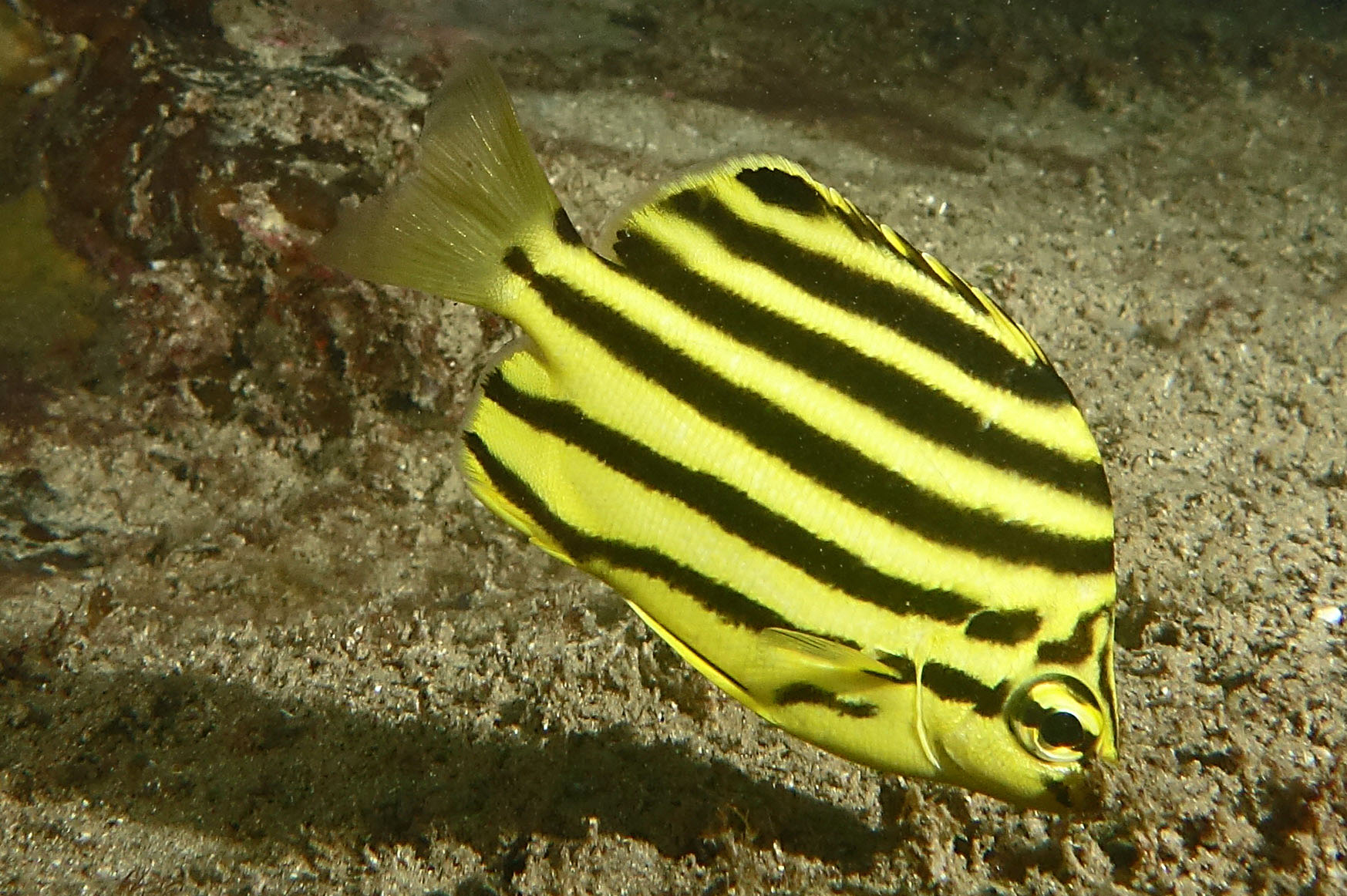East-Australian Stripey, Microcanthus joyceae Whitley 1931

An East-Australian Stripey, Microcanthus joyceae, at Fairy Bower, Manly, New South Wales. Source: John Turnbull / Flickr. License: CC by Attribution-NonCommercial-ShareAlike
Summary:
A yellow stripey with five horizontal dark stripes reaching the rear edges of the dorsal and anal fins, and the base of the caudal fin. The fifth body stripe is relatively straight, without an inflection toward the anal-fin origin, and the species lacks spots and short dashes on the breast and lower body.
Cite this page as:
Bray, D.J. 2022, Microcanthus joyceae in Fishes of Australia, accessed 01 Jul 2025, https://fishesofaustralia.net.au/Home/species/5654
East-Australian Stripey, Microcanthus joyceae Whitley 1931
More Info
|
Distribution |
Central Queensland to southern New South Wales; also the Lord Howe Province and Norfolk Island in the Tasman Sea. Elsewhere the species occurs in New Caledonia. Inhabits rocky and coral reefs in bays, harbours and coastal waters, sometimes forming large schools - commonly at depths of 10-30 m. Juveniles are often seen in tide pools, and adults often hang around jetty and wharf pylons. |
|
Features |
Dorsal fin XI,15–17; Anal fin III,13–14; Pectoral fin 15–17; Upper procurrent caudal-fin rays 8–9, lower procurrent caudal-fin rays 7–9; Caudal fin total rays 32–35; Diagonal rows of scales in lateral series 49–58; Circumpeduncular scales 26–28; Gill rakers 16–17; Branchiostegals 7. Body laterally compressed, moderately tall and roughly circular in lateral view, dorsal-fin origin to pelvic-fin origin 54.1–59.8% SL. |
|
Similar Species |
Differs from the Stripey, Microcanthus strigatus, from Western Australia, in having a relatively straight fifth body stripe, without an inflection, and in lacking spots and short dashes on the breast and lower part of the body. |
|
Etymology |
The species is 'named in honour of Miss Joyce K. Allan of the Australian Museum, to whom I am indebted for the excellent illustrations of this species'. |
|
Species Citation |
Microcanthus joycae Whitley 1931, Records of the Australian Museum 18(3): 111, Pl. 13 (figs. 4-5). Type locality: Shellharbour, New South Wales, Australia. |
|
Author |
Bray, D.J. 2022 |
|
Resources |
East-Australian Stripey, Microcanthus joyceae Whitley 1931
References
Allen, G.R., Hoese, D.F., Paxton, J.R., Randall, J.E., Russell, B.C., Starck, W.A., Talbot, F.H. & Whitley, G.P. 1976. Annotated checklist of the fishes of Lord Howe Island. Records of the Australian Museum 30(15): 365-454 figs 1-2 (as Microcanthus strigatus)
Francis, M. 1993. Checklist of the coastal fishes of Lord Howe, Norfolk, and Kermadec Islands, southwest Pacific Ocean. Pacific Science 47(2): 136-170 figs 1-2 (as Microcanthus strigatus) See ref online
Francis, M. 2019. Checklist of the coastal fishes of Lord Howe, Norfolk and Kermadec Islands, southwest Pacific Ocean.Version 2019.1 https://doi.org/10.6084/m9.figshare.c.4428305(as Microcanthus strigatus)
Johnson, J.W. 2010. Fishes of the Moreton Bay Marine Park and adjacent continental shelf waters, Queensland, Australia. pp. 299-353 in Davie, P.J.F. & Phillips, J.A. Proceedings of the Thirteenth International Marine Biological Workshop, The Marine Fauna and Flora of Moreton Bay. Memoirs of the Queensland Museum 54(3) (as Microcanthus strigatus)
Knudsen, S.W. & Clements, K.D. 2013. Revision of the family Kyphosidae (Teleostei: Perciformes). Zootaxa 3751(1): 1-101. (as Microcanthus strigatus)
Kuiter, R.H. 1993. Coastal Fishes of South-Eastern Australia. Crawford House Press. 437 pp. (as Microcanthus strigatus)
Randall, J.E., Allen, G.R. & Steene, R. 1990. Fishes of the Great Barrier Reef and Coral Sea. Bathurst : Crawford House Press 507 pp. figs. (as Microcanthus strigatus)
Randall, J.E., Allen, G.R. & Steene, R.C. 1997. Fishes of the Great Barrier Reef and Coral Sea. Crawford House Press. 557 pp. (as Microcanthus strigatus)
Upston, J. & Booth, D.J. 2003. Settlement and density of juvenile fish assemblages in natural, Zostera capricorni (Zosteraceae) and artificial seagrass beds. Environmental Biology of Fishes 66: 91-97. (as Microcanthus strigatus)
White, G.E., Hose, G.C. & Brown, C. 2015. Influence of rock-pool characteristics on the distribution and abundance of inter-tidal fishes. Marine Ecology 36: 1332-1344. (as Microcanthus strigatus)
Tea, Y.-K. & Gill, A.C. 2020. Systematic reappraisal of the anti-equatorial fish genus Microcanthus Swainson (Teleostei: Microcanthidae), with redescription and resurrection of Microcanthus joyceae Whitley. Zootaxa 4802 (no. 1): 41-60. https://doi.org/10.11646/zootaxa.4802.1.3
Tea, Y.‐K., Van Der Wal, C., Ludt, W.B., Gill, A.C., Lo, N. & Ho, S.Y.W. 2019. Boomeranging around Australia: Historical biogeography and population genomics of the anti‐equatorial fish Microcanthus strigatus (Teleostei: Microcanthidae). Molecular Ecology 2019; 15pp. https://doi.org/10.1111/mec.15172
Whitley, G.P. 1931. Studies in ichthyology. No. 4. Records of the Australian Museum 18(3): 96-133, Pls. 9-16. https://doi.org/10.3853/j.0067-1975.18.1931.720 (described as both Microcanthus joyceae and M. howensis)








